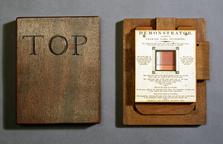

Arithmetical Jewel, 1619.
- Made:
- circa 1619 in England








Arithmetical Jewel : a seventeenth century calculating device of ivory and brass in tooled leather binding, 5" x 3", with brass stylus 5 inches long, bound with 33 sheets of contemporary MS instructions and 7 blank sheets
The 'Arithmetical Jewel' publicised by William Pratt in 1619. This instrument combines features of an abacus with those of pen reckoning. Numbers are put in by moving the flags to reveal dots. Sums are then worked out with a pen and paper.
Details
- Category:
- Mathematics
- Object Number:
- 1952-206
- Materials:
- leather, brass (copper, zinc alloy), velvet, ivory and paper (fibre product)
- Measurements:
-
Closed: 130 mm x 135 mm x 26 mm, 0.14 kg
- type:
- abacus
- credit:
- Weil, E.



